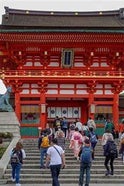Shinto

Shinto is the traditional religion of Japan, and unlike many world religions, it has no single founder, no sacred scripture like a Bible or Qur’an, and no fixed set of beliefs. Instead, Shinto developed naturally from ancient Japanese culture and folklore, with deep respect for nature, spirits, and tradition. The word “Shinto” means “the way of the gods.”
Shinto has been practiced in Japan for thousands of years, evolving alongside Japanese history. While Buddhism later entered Japan and mixed with Shinto practices, Shinto remained tied to cultural rituals, ceremonies, and festivals. It played a key role in Japan’s national identity and is still widely practiced today, especially during life events like births, weddings, and festivals.
Shinto is less focused on strict theology and more focused on rituals, purity, and respect for spirits known as kami.
Here are some key ideas in Shinto:
-
Kami – Spiritual beings or forces found in nature, objects, ancestors, and even emotions. Mountains, rivers, trees, and animals may all house kami. Some kami are major deities like Amaterasu, the sun goddess and mythological ancestor of the Japanese emperors.
-
Purification (Harae) – Cleanliness is essential in Shinto. Rituals often begin with washing hands and mouth at a shrine to remove spiritual impurity.
-
Shrines (Jinja) – Sacred places where people go to honor kami. They’re usually found in beautiful natural settings, with gates called torii marking the transition from the normal world to sacred space.
-
Offerings and Prayers – Visitors to a shrine may ring a bell, bow, clap, and leave small offerings like coins or food to honor the kami.
-
Matsuri (Festivals) – Colorful celebrations that honor the kami of local shrines. These often include parades, music, dancing, and traditional clothing.
-
Ancestral Worship – Honoring deceased family members is an important part of Shinto practice. Many Japanese households have small altars for remembering loved ones.
Shinto encourages harmony between people and nature and focuses on this life, not the next. It doesn't offer strict rules or commandments just guidance for living respectfully and gratefully.
Shinto doesn’t have a strong focus on the afterlife. While some believe in a spirit world or continuation of the soul, most Shinto practice is centered on living well in the present and maintaining harmony with the kami and ancestors. Funerals in Japan often follow Buddhist traditions, showing how the two religions are often practiced side by side.
Shinto is a celebration of life, nature, and tradition. It teaches people to live in harmony with the world around them, to honor the unseen forces that shape our lives, and to keep things pure—both physically and spiritually. Though uniquely Japanese, Shinto’s messages of respect, gratitude, and connection to nature are meaningful far beyond its homeland.
Create Your Own Website With Webador